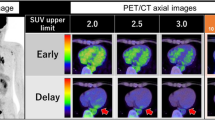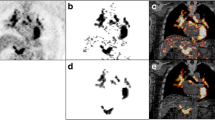Abstract
Background
The purpose of this study was to determine the feasibility of serial quantitative 2-deoxy-2-[18F]fluoro-D-glucose (FDG) positron emission tomography (PET) to monitor the response of cardiac sarcoidosis to treatment.
Methods and Results
A total of 38 PET scan intervals (54 PET scans) were obtained in 16 patients with cardiac sarcoidosis who underwent serial FDG PET during treatment. FDG-avid lesions of the heart were interpreted quantitatively using 4 PET parameters: maximum standardized uptake value (SUVmax), partial volume corrected mean standardized uptake value (SUVmean), partial volume corrected metabolic volume product (MVP), and global metabolic volume product (gMVP). Clinical response to treatment (improved, stable, or progressive disease) was evaluated by clinical symptoms, NYHA class, and EKG in all the patients. SUVmax, SUVmean, MVP, and gMVP had significantly decreased value on repeat PET in patients who were either stable or showed clinical improvement between two serial PET scans, while none of them had significant change on repeat PET in patients who were clinically worse. Correlation analysis between PET findings and clinical assessment revealed that the changes of SUVmax and SUVmean on repeat PET were negatively correlated with patient’s clinical outcome.
Conclusion
Our results indicated that serial FDG PET is feasible to determine the extent of disease activity and to quantitatively assess the response of cardiac sarcoidosis to therapy.
Spanish Abstract
Antecedentes
El propósito de este estudio fue determinar la factibilidad del estudio PET con FDG cuantitativo realizado en forma seriada para monitorear la respuesta de la sarcoidosis cardiaca al tratamiento.
Métodos y resultados
Se obtuvieron estudios PET en un total de 38 intervalos (54 estudios PET) en 16 pacientes con sarcoidosis cardiaca quienes fueron sometidos al estudio de PET FDG seriado durante su tratamiento. Las lesiones cardiacas ávidas de FDG fueron interpretadas cuantitativamente utilizando 4 parámetros de PET: el valor de captación máximo estandarizado (SUVmax por sus siglas en ingles), valor de captación promedio estandarizado corregido por volumen parcial (SUVmean por sus siglas en ingles), el producto volumen metabólico corregido por el volumen parcial (MVP por sus siglas en ingles) y el producto volumen metabólico global (gMVP por sus siglas en ingles). La respuesta clínica al tratamiento (mejoría, estable o progresión de la enfermedad) fue evaluada en base a los síntomas, la clase funcional de acuerdo a la clasificación de NYHA y ECG en todos los pacientes. Todas las variables cuantitativas SUVmax, SUVmean, MVP y gMVP habían disminuido su valor de forma significativa en el estudio PET de repetición en los pacientes estables o con mejoría clínica entre los dos estudios de PET seriados, mientras que ninguna de ellas tuvo un cambio significativo en el PET de repetición en los pacientes que cursaron con deterioro clínico. El análisis de correlación entre los resultados del PET y la evaluación clínica, reveló que los cambios en los valores SUVmáx y SUVmean en el PET de repetición se correlacionaron de forma negativa con el resultado clínico del paciente.
Conclusión
Nuestros resultados indican el estudio PET con FDG seriado es factible para determinar el grado de actividad de la enfermedad y para evaluar cuantitativamente la respuesta de sarcoidosis cardiaca al tratamiento.
Chinese Abstract
背景
本研究目的是探討FDG PET 连续定量分析應用在評估心脏结节病治疗效果的可行性。
方法和结果
共16 名患有心脏结节病并在治疗过程中以FDG PET扫描作為治療監測的病人。這16位病人接收了54次PET 扫描, 38 个PET 扫描间隔。心脏病灶的FDG PET 显像利用以下参数定量:最大标准摄取值 (SUVmax), 部分体积纠正的平均标准摄取值(SUVmean), 部分体积纠正的代谢体积产物 (MVP), 和整体代谢体积产物(gMVP) 。所有病人的治療效果均以临床症状, NYHA 级别, 及EKG 来评估, 分別為好转、稳定或恶化。对比两次连续的PET 扫描,對于好转和稳定的病人, 其SUV-max, SUVmean, MVP, 和gMVP 都有明显的降低; 然而,对于恶化的病人,这四个指标都没有改变。相关性分析显示SUVmax 和SUVmean 的改变与病人的临床治療反应呈负相关。
结论
FDG PET 连续定量分析可以用来定量评估心脏结节病的活动性以及治疗反应。



Similar content being viewed by others
References
Prabhakar HB, Rabinowitz CB, Gibbons FK, O’Donnell WJ, Shepard J-AO, Aquino SL. Imaging features of sarcoidosis on MDCT, FDG PET, and PET/CT. Am J Roentgenol 2008;90:S1-6.
Yazaki Y, Isobe M, Hiroe M, Morimoto S, Hiramitsu S, Nakano T, et al. Prognostic determinants of long-term survival in Japanese patients with cardiac sarcoidosis treated with prednisone. Am J Cardiol 2001;88:1006-10.
Grutters JC, van den Bosch JM. Corticosteroid treatment in sarcoidosis. Eur Respir J 2006;28:627-36.
Chiu CZ, Nakatani S, Zhang G, Tachibana T, Ohmori F, Yamagishi M, et al. Prevention of left ventricular remodeling by long-term corticosteroid therapy in patients with cardiac sarcoidosis. Am J Cardiol 2005;95:143-6.
Kim JS, Judson MA, Donnino R, Gold M, Cooper LT Jr, Prystowsky EN, et al. Cardiac sarcoidosis. Am Heart J 2009;157:9-21.
Treglia G, Annunziata S, Sobic-Saranovic D, Bertagna F, Caldarella C, Giovanella L. The role of 18F-FDG-PET and PET/CT in patients with sarcoidosis: An updated evidence-based review. Acad Radiol 2014;21:675-84.
Yamagishi H, Shirai N, Takagi M, Yoshiyama M, Akioka K, Takeuchi K, et al. Identification of cardiac sarcoidosis with (13)N-NH(3)/(18)F-FDG PET. J Nucl Med 2003;44:1030-6.
Okumura W, Iwasaki T, Toyama T, Iso T, Arai M, Oriuchi N, et al. Usefulness of fasting 18F-FDG PET in identification of cardiac sarcoidosis. J Nucl Med 2004;45:1989-98.
Ishimaru S, Tsujino I, Takei T, Tsukamoto E, Sakaue S, Kamigaki M, et al. Focal uptake on 18F-fluoro-2-deoxyglucose positron emission tomography images indicates cardiac involvement of sarcoidosis. Eur Heart J 2005;26:1538-43.
Ohira H, Tsujino I, Ishimaru S, Oyama N, Takei T, Tsukamoto E, et al. Myocardial imaging with 18F-fluoro-2-deoxyglucose positron emission tomography and magnetic resonance imaging in sarcoidosis. Eur J Nucl Med Mol Imaging 2008;35:933-41.
Langah R, Spicer K, Gebregziabher M, Gordon L. Effectiveness of prolonged fasting 18f-FDG PET-CT in the detection of cardiac sarcoidosis. J Nucl Cardiol 2009;16:801-10.
Tahara N, Tahara A, Nitta Y, Kodama N, Mizoguchi M, Kaida H, et al. Heterogeneous myocardial FDG uptake and the disease activity in cardiac sarcoidosis. JACC Cardiovasc Imaging 2010;3:1219-28.
Mc Ardle BA, Birnie DH, Klein R, de Kemp RA, Leung E, Renaud J, et al. Is there an association between clinical presentation and the location and extent of myocardial involvement of cardiac sarcoidosis as assessed by 18F-fluorodeoxyglucose positron emission tomography? Circ Cardiovasc Imaging 2013;6:617-26.
Osborne MT, Hulten EA, Singh A, Waller AH, Bittencourt MS, Stewart GC, et al. Reduction in 18F-fluorodeoxyglucose uptake on serial cardiac positron emission tomography is associated with improved left ventricular ejection fraction in patients with cardiac sarcoidosis. J Nucl Cardiol 2014;21:166-74.
Blankstein R, Osborne M, Naya M, Waller A, Kim CK, Murthy VL, et al. Cardiac positron emission tomography enhances prognostic assessments of patients with suspected cardiac sarcoidosis. J Am Coll Cardiol 2014;63:329-36.
Torigian DA, Lopez RF, Alapati S, Bodapati G, Hofheinz F, van den Hoff J, et al. Feasibility and performance of novel software to quantify metabolically active volumes and 3D partial volume corrected SUV and metabolic volumetric products of spinal bone marrow metastases on 18F-FDG-PET/CT. Hellenic J Nucl Med 2011;14:8-14.
Basu S, Saboury B, Torigian DA, Alavi A. Current evidence base of FDG-PET/CT imaging in the clinical management of malignant pleural mesothelioma: Emerging significance of image segmentation and global disease assessment. Mol Imaging Biol 2011;13:801-11.
Wahl RL, Jacene H, Kasamon Y, Lodge MA. From RECIST to PERCIST: Evolving considerations for PET response criteria in solid tumors. J Nucl Med 2009;50:122S-50S.
Cheng VY, Slomka PJ, Ahlen M, Thomson LE, Waxman AD, Berman DS. Impact of carbohydrate restriction with and without fatty acid loading on myocardial 18F-FDG uptake during PET: A randomized controlled trial. J Nucl Cardiol 2010;17:286-91.
Soussan M, Brillet P-Y, Nunes H, Pop G, Ouvrier M-J, Naggara N, et al. Clinical value of a high-fat and low-carbohydrate diet before FDG-PET/CT for evaluation of patients with suspected cardiac sarcoidosis. J Nucl Cardiol 2013;20:120-7.
Adams H, Keijsers RG, Korenromp IHE, Grutters JC. FDG PET for gauging of sarcoid disease activity. Sem Respir Crit Care Med 2014;35:352-61.
Kaneta T, Hakamatsuka T, Takanami K, Yamada T, Takase K, Sato A, et al. Evaluation of the relationship between physiological FDG uptake in the heart and age, blood glucose level, fasting period, and hospitalization. Ann Nucl Med 2006;20:203-8.
Inglese E, Leva L, Matheoud R, Sacchetti G, Secco C, Gandolfo P, et al. Spatial and temporal heterogeneity of regional myocardial uptake in patients without heart disease under fasting conditions on repeated whole-body 18F-FDG PET/CT. J Nucl Med 2007;48:1662-9.
Fukuchi K, Ohta H, Matsumura K, Ishida Y. Benign variations and incidental abnormalities of myocardial FDG uptake in the fasting state as encountered during routine oncology positron emission tomography studies. Br J Radiol 2007;80:3-11.
Pandya C, Brunken RC, Tchou P, Schoenhagen P, Culver DA. Detecting cardiac involvement in sarcoidosis: A call for prospective studies of newer imaging techniques. Eur Respir J 2007;29:418-22.
Crouser ED, Ono C, Tran T, He X, Raman SV. Improved detection of cardiac sarcoidosis using magnetic resonance with myocardial T2 mapping. Am J Respir Crit Care Med 2014;189:109-12.
Ratib O, Nkoulou R. Potential applications of PET/MR imaging in cardiology. J Nucl Med 2014;55:40S-6S.
Nensa F, Tezgah E, Poeppel T, Nassenstein K, Schlosser T. Diagnosis and treatment response evaluation of cardiac sarcoidosis using positron emission tomography/magnetic resonance imaging. Eur Heart J 2015;36:550.
Lu Y, Sweiss NJ. MRI and FDG PET/CT imaging manifestations of cardiac sarcoidosis. Clin Nucl Med 2015;40:973-4.
Basu S, Saboury B, Werner T, Alavi A. Clinical utility of FDG-PET and PET/CT in non-malignant thoracic disorders. Mol Imaging Biol 2011;13:1051-60.
Dibble EH, Alvarez ACL, Truong M-T, Mercier G, Cook EF, Subramaniam RM. 18F-FDG metabolic tumor volume and total glycolytic activity of oral cavity and oropharyngeal squamous cell cancer: Adding value to clinical staging. J Nucl Med 2012;53:709-15.
Umeda Y, Demura Y, Morikawa M, Ameshima S, Tsuchida T, Fujibayashi Y, et al. Prognostic value of dual-time-point 18F-fluorodeoxyglucose positron emission tomography in patients with pulmonary sarcoidosis. Respirology 2011;16:713-20.
Disclosure
The authors declared that they have nothing to disclose.
Author information
Authors and Affiliations
Corresponding author
Additional information
See related editorial, doi:10.1007/s12350-016-0721-y.
JNC thanks Erick Alexanderson MD, Carlos Guitar MD, and Diego Vences MD, UNAM, Mexico for their work in providing the Spanish abstract.
JNC thanks Haipeng Tang, MS, School of Computing, University of Southern Mississippi; Zhixin Jiang, MD, Department of Cardiology, The First Affiliated Hospital of Nanjing Medical University, Nanjing, China; and Weihua Zhou, PhD, School of Computing, University of Southern Mississippi, for providing the Chinese abstract.
Rights and permissions
About this article
Cite this article
Lee, PI., Cheng, G. & Alavi, A. The role of serial FDG PET for assessing therapeutic response in patients with cardiac sarcoidosis. J. Nucl. Cardiol. 24, 19–28 (2017). https://doi.org/10.1007/s12350-016-0682-1
Received:
Accepted:
Published:
Issue Date:
DOI: https://doi.org/10.1007/s12350-016-0682-1




